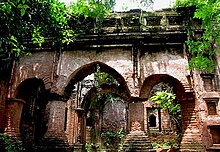| Gopa (Ahir) | |
|---|---|
| Kuladevta (male) | Shri Krishna |
| Religions | Hinduism |
| Languages | Varies depending on region |
| Populated states | India and Nepal |
| Subdivisions | Krishnaut, Majhraut, Sadgop |
Gopa or Gop or Gope is a synonym of the Yadav (Ahir) caste. It is generally used as a title by the Ahir caste in the states of Bihar, Jharkhand and West Bengal of East India and even in Terai region of Nepal.
Etymology
The Sanskrit word Gopa, originally meant only a cowherd; it then came to mean the head of cowpen and lastly the chief of a tribe.
Origin and history
Kingdom

- Gopala Dynasty and Mahisapala dynasty of Nepal, it was established by the Gopa or Abhira.
- Sadgop Dynasty of Gopbhum. It had two Sadgop (Gopa) kings, one ruled from Amrargar and other from Dhekur (also known as Trisasthigar).
- Sadgop rulers of Midnapore Raj and Narajole Raj.
- Sadgop Kings of Narayangarh and Balrampur.
- Gopa (Ahir) chieftain and zamindari of Murho Estate, Parasadi Estate, Belwarganj Estate, Ranipatti Estate, Tintanga Estate, Surul Raj, Hadal-Narayanpur Estate, Kalikapura Raj etc. in Bihar and West Bengal.
Gop Jatiye Mahasabha
Gop Jatiye Mahasabha was formed by Babu Ras Bihari Lal Mandal in 1911, It was the regional organization of Gope caste of Bihar, Bengal & Orissa.
Later, the All-India Yadav Mahasabha was formed by merging the Gop Jatiye Mahasabha and Ahir/Yadav Kshatriya Mahasabha. AIYM first National Conference was held in Purnea, Bihar on 17 to 20 April 1924.
Present circumstances
Gopa or Ahir are mainly a landholding community and they are rich cultivators in Indian state of Bihar, Jharkhand and West Bengal.
See also
- Yadav
- Ahir
- Bihari Ahir
- Sadgop
- Krishnuat
References
- Singh, K. S. (2008). People of India: Bihar (2 pts.). Anthropological Survey of India. ISBN 978-81-85579-09-2.
- Rao, M. S. A. (1987). Social Movements and Social Transformation: A Study of Two Backward Classes Movements in India. Manohar. ISBN 978-0-8364-2133-0.
- Madhusudan Das (1980). Madhusudan Das, the Legislator: His Speeches. Pragati Utkal Sangha.
- Dalip Kumar (2007). Rural Development and Social Change: Thoughts of Swami Sahajanand. Deep & Deep Publications. pp. 106–. ISBN 978-81-8450-000-4.
- Singh, Santosh (9 October 2015). Ruled or Misruled: Story and Destiny of Bihar. Bloomsbury Publishing. ISBN 978-93-85436-42-0.
- Singh, Kumar Suresh (2008). People of India: Bihar, including Jharkhand (2 pts). Anthropological Survey of India. ISBN 978-81-7046-303-0.
- Singh, Kumar Suresh (1998). India's Communities. Oxford University Press. ISBN 978-0-19-563354-2.
- Yadav, Sohan Ram (1992). Rural and Agrarian Social Structure of Nepal. Commonwealth Publishers. ISBN 978-81-7169-174-6.
- Alexander, James Bradun (1893). The Dynamic Theory of Life and Mind: An Attempt to Show that All Organic Beings are Both Constructed and Operated by the Dynamic Agencies of Their Respective Environments. Housekeeper Press.
- Humboldt library of science. no. 131 | pt. 2, 1890. Humboldt Publishing Company. 1890.
- Rogozin, Z. A. (2005). Vedic India: As Embodied Principally In The Rigveda. Cosmo Publications. ISBN 978-81-307-0085-4.
- "Gopegarh Eco Park: Where nature is your only companion". www.outlookindia.com/outlooktraveller/. Archived from the original on 24 February 2022. Retrieved 9 March 2021.
- Nepālī Saṃskr̥ta abhilekhoṃ kā Hindī anuvāda (in Hindi). Īsṭarna Buka Liṅkarsa. 1985. Archived from the original on 17 March 2023. Retrieved 29 March 2021.
- Satyal, Yajna Raj (1988). Tourism in Nepal: A Profile. Nath Publishing House. Archived from the original on 17 March 2023. Retrieved 29 March 2021.
- Bengal (India), West (1965). West Bengal District Gazetteers: Barddhamān. State editor, West Bengal District Gazetteers.
- Smith, William L. (1980). The One-eyed Goddess: A Study of the Manasā Maṅgal. Almqvist & Wiksell International. ISBN 978-91-22-00408-0.
- McLane, John R. (25 July 2002). Land and Local Kingship in Eighteenth-Century Bengal. Cambridge University Press. ISBN 978-0-521-52654-8.
- McLane, John R. (25 July 2002). Land and Local Kingship in Eighteenth-Century Bengal. Cambridge University Press. ISBN 978-0-521-52654-8. Archived from the original on 23 March 2021. Retrieved 10 March 2021.
- Bandyopadhyay, Sekhar (1 July 2004). Caste, Culture and Hegemony: Social Dominance in Colonial Bengal. SAGE Publications India. ISBN 978-81-321-0407-0.
- "A village that symbolises Bihar". www.rediff.com. Archived from the original on 12 February 2022. Retrieved 21 February 2021.
- "Murho". wikimapia.org. Archived from the original on 9 May 2019. Retrieved 21 February 2021.
- "This Ancient Rajbari Might Soon Be Listed On The Heritage Tourism Map of Incredible India". Whats Hot. Archived from the original on 17 March 2023. Retrieved 8 March 2021.
- Madhusudan Das (1980). Madhusudan Das, the Legislator: His Speeches. Archived 2023-03-17 at the Wayback Machine Pragati Utkal Sangha.
- Banerjee, Supurna; Ghosh, Nandini (17 September 2018). Caste and Gender in Contemporary India: Power, Privilege and Politics-Google Books. ISBN 9780429783951. Archived from the original on 17 March 2023. Retrieved 14 June 2020.
- Alam, Jawaid (January 2004). Government and Politics in Colonial Bihar, 1921-1937. ISBN 8170999790. Archived from the original on 17 March 2023. Retrieved 14 June 2020.
- Banerjee, Supurna; Ghosh, Nandini (17 September 2018). Caste and Gender in Contemporary India: Power, Privilege and Politics. Taylor & Francis. ISBN 978-0-429-78395-1.
- Bandyopadhyay, Suraj; Rao, A. R.; Sinha, Bikas Kumar; Sinha, Bikas K. (2011). Models for Social Networks With Statistical Applications. SAGE. ISBN 978-1-4129-4168-6. Archived from the original on 17 March 2023. Retrieved 9 March 2021.